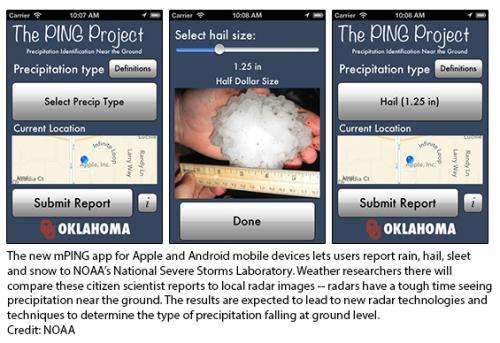New smart phone app lets public report rain, hail, sleet and snow to NOAA

It's now easier than ever to be a part of NOAA's weather research. The NOAA National Severe Storms Laboratory, in partnership with the University of Oklahoma, has launched a free app for users to anonymously report precipitation from their Apple or Android mobile device.
With the mPING app, anyone can send a weather observation on the go. The user simply opens the app, selects the type of precipitation that is falling at his or her location, and presses submit. The user's location and the time of the observation are automatically included in the report.
All submissions will become part of a research project called PING – Precipitation Identification Near the Ground. NSSL and OU researchers will use the mPING submissions to build a valuable database of tens of thousands of observations from across the United States.
The new mPING app for Apple and Android mobile devices lets users report rain, hail, sleet and snow to NOAA's National Severe Storms Laboratory.
"mPING gives the public a unique opportunity to act as citizen scientists, allowing them to report their observations of precipitation—such as snow, rain, ice pellets, or a mix—in real time," said principal investigator Kim Elmore, Ph.D., research meteorologist with the NOAA Cooperative Institute for Mesoscale Meteorological Studies (CIMMS) at the University of Oklahoma. "Because this nation-wide information will be instantly available from one website, we believe it will be useful for not only researchers, but a variety of groups, including students and teachers, forecasters, TV meteorologists, members of the transportation and aviation industries, city managers and law enforcement."
In addition to reporting winter precipitation, mPING users can report observations of hail occurrence and hail size during the summer months, Elmore added.
All reports in the PING database, both past and real-time, can be viewed on the project's web site. This allows anyone to see all observations in time and space to better identify the locations where hazardous forms of precipitation exist.
To further analyze the data, researchers will compare the reports with what radars detect and use the information to develop new radar and forecasting technologies and techniques.
The apps are available on iTunes or Google Play for use on both phones and tablets. They were developed by OU under the CIMMS agreement and are owned by OU.
Provided by NOAA Headquarters















.jpg)




